The Amazon basin includes 550 Mha covered with rainforests, and 60% of this area is in Brazil. The conversion of rainforest for soybean production raises concerns about how Brazil can reconcile production and environmental goals. Here we investigated the degree to which intensification could help Brazil produce more soybean without further encroachment on the Amazon forest. Our analysis shows that the continuation of current trends in soybean yield and area would lead to the conversion of an additional 5.7 Mha of forests and savannahs during the next 15 years, with an associated 1,955 Mt of CO2e released into the atmosphere. In contrast, the acceleration of yield improvement, coupled with the expansion of soybean area only in areas currently used for livestock production, would allow Brazil to produce 162 Mt of soybean without deforestation and with 58% lower global climate warming relative to that derived from the continuation of current trends.
A key message from our study is that, without an emphasis on intensifying crop production within the existing agricultural area, coupled with strong institutions and policies that prevent deforestation in frontier agricultural areas, it would be difficult to protect the last bastions of forests and biodiversity on the planet while being sensitive to the economic aspirations of countries to develop.































